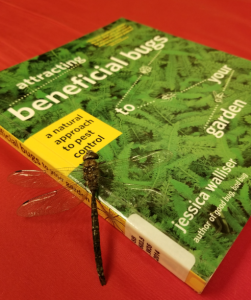Have you every wondered if that unknown insect scuttling around in your garden is a threat to your carefully nurtured plants? Or how to keep ladybugs in your garden and decimate the aphids that cropped up in your ornamental flower bed? Have you ever felt overwhelmed by an onslaught of garden pests, but have been reluctant to rely on chemical pesticides?
If you’ve needed an answer to any of these questions or have been seeking an introduction to alternative pest control methods, then Jessica Walliser’s Attracting Beneficial Bugs to Your Garden is the book for you! This book is an excellent resource for gardeners seeking to develop a better understanding of the often-complex relationships between their gardens and the insects that live (or don’t live) in them. Readily available, and presented in an easy to read format, Walliser delivers a solid basis for gardeners to identify beneficial insects by family and provide for them within their gardens. For the more insect-averse, the book succinctly explains core concepts in biology and ecology, such as the predator-prey dynamic and biodiversity, to stress the importance of insects in the garden ecosystem.
While this book is not Alaska specific, gorgeous full color photos that help orient readers to what they’ve seen outside with the detailed beneficial insect profiles describing their life histories, general characteristics, and preferred prey. By focusing on identifying insects on the family level rather than focusing on the minutiae that identify species, this book can help gardeners develop a basic knowledge of different insects that can then improved upon with more locally relevant knowledge of insect species. More information about specific local insect species and pests can be found on the UAF Cooperative Extension’s Publications Page, or any other local Cooperative Extension’s Publications Page.
Of course, this wouldn’t be a book for gardeners without addressing the plants necessary for enticing beneficial insects to take up residence in gardens! Just as a portion of the book overviews relevant insects, another large portion of the book provides plant profiles with accompanying information on which beneficial insects are likely to be attracted to them. In contrast to the insect profiles, the plant profiles specify species. Despite this, just as mentioned above, by utilizing local resources such as UAF Cooperative Extension’s recommended variety lists by region, local gardeners will likely be able to cross reference suggested species with Alaska-viable cultivars or find similar alternatives.
To bring it all together, the book also has a chapter that details how gardeners should think plan for and design their gardens for beneficial insects. Further, for those who are wary of attempting to integrate planning gardening plots independently, the book contains four different garden plans that can be used as a base to develop your Alaskan garden.
In short, Attracting Beneficial Bugs to Your Garden, used in combination with other local resources, can help any gardener turn their garden into a more bio-diverse and productive garden. Check it out or request it at your local Alaskan library today!
Additional Resources
Beneficial Insects and Spiders of Alaska by Jessie Moan
The Bee-Friendly Garden by Kate Frey and Gretchen LeBuhn
About sshammond2
Twitter •
